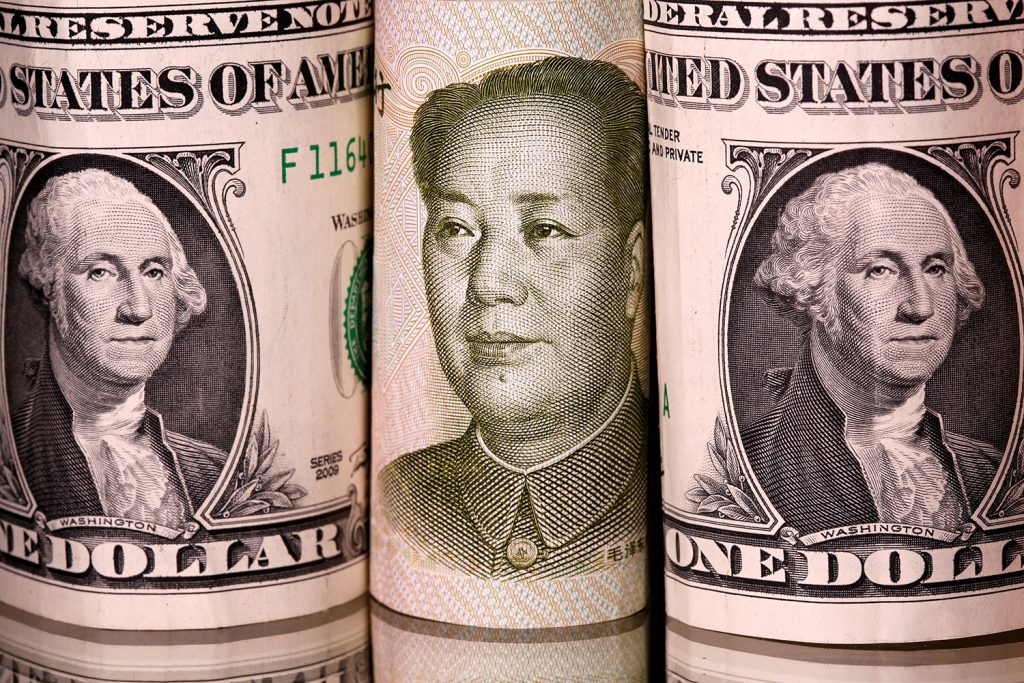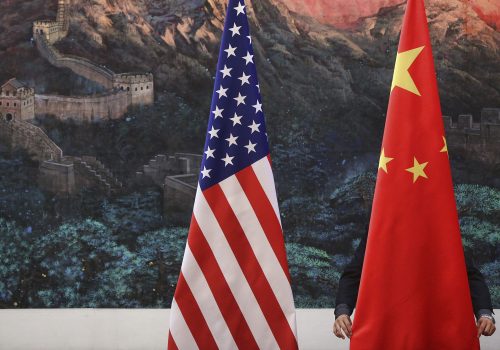During the first COVID-19 stimulus debate in late March, the US Congress discussed creating a digital dollar regulated by the Federal Reserve to increase the speed of stimulus payments to US households. Senior Congressional leaders promoted the ambitious idea of a centralized digital currency and “digital dollar wallets,” which could be utilized particularly by Americans who do not have access to banks for direct deposit and check cashing purposes. While Congress did not end up doing this, the growing discussion around it is a noteworthy development for the future of digital currencies. Implanting a digital dollar will set an important precedent for central banks around the world who might follow in the footsteps of the US Federal Reserve. They would most likely create more Central Bank Digital Currencies (CBDCs) and highlight notoriously difficult-to-track illicit financing threats. Because the future financial order is trending digital, it is essential that the United States avoid complacency and successfully establish a digital currency before China to cement America’s status as the current and future world economic leader.
Throughout the 21st century, the dollar has been a vital asset to Americans and countries around the world to mark their economic might, especially in times of crisis. As a result, it has become more important than ever for the United States to hold onto this hard-earned authority. In an era of globalized trade and increasing interconnectedness, this authority is challenged by China, who seeks to gain more economic bargaining influence over countries that peg their currency to the greenback. Though the US dollar has faced multiple critical inflection points in the battle to preserve confidence in its performance, it has managed to retain its position, currently holding 61 percent of all known central bank foreign exchange reserves compared to the Chinese yuan which makes up only 2 percent of global payments and reserves.
As the COVID-19 crisis continues to cast a shadow over the future of the global economy, the dollar, while currently surging, finds itself at another larger inflection point; it needs to again prove its worth as the essential global currency. With central banks across the globe aspiring to rapidly issue stimuluses and rebuild their respective systems after the economic fallout of COVID-19, the world will go through a period of intense competition as exchange rates fluctuate and currencies experience periods of large-scale depreciation.
This gives China the opportunity to again start convincing the international community to switch to an alternative global currency; however, as Kori Schake stated, this was a true “lost opportunity for the yuan… the Federal Reserve has made a breathtaking expansion as the effective central banker to the world.” The Federal Reserve injecting trillions of dollars into the financial system and opening dollar swap lines with central banks around the world has reinforced global confidence in the greenback while undermining Chinese yuan influence.
Despite this confidence, the US economic system has revealed its fundamental weaknesses in its attempt to rollout an effective long-term economic stimulus plan for all aspects of the US economy. Those shortcomings, coupled with this new digital age, call for transformative policymaking and a bold shift to a digital economic future. It is imperative Congress act in this unique time instead of waiting for a recovery. If we wait too long, the Chinese will become dominant in this space before the United States has a chance to do so.
Over the course of the past five years, China has been in the developmental stages of rolling out their own automated payment system called DCEP, or Digital Currency Electronic Payment, which is expected to be introduced this year. In 2014, The Central Bank of China assembled a special task force to conduct research on digital currencies and established the Research Institute of Digital Currency. With its recent test pilot launching a digital currency, China seeks to promote the internationalization of the renminbi, which has largely stalled since 2015. China hopes that the digital renminbi can be used in cross border payments without going through banking intermediaries, effectively avoiding the US financial system and leverage of US sanctions.
This platform varies from other forms of digital currencies because it eliminates the need for an intermediary role in the traditional system of “checks” made by a bank before a transaction is settled. In this new system, the digital yuan (which would be backed 1:1 by the paper yuan) would allow a direct exchange between the central bank and other parties in a far more efficient process. While the possibilities for applications of this Chinese digital currency are wide ranging and begin to hint at the potential uses of AI in implementation, the world naturally seeks a response from a US administration that is less prepared for such a change. This shift could hold great international importance as China utilizes its newfound “workaround” strategy to reduce the global significance of the greenback and US sanctions power.
It is incredibly important to note China’s desire to connect to mobile devices, whereas, debates in US Congress have shown some push to integrate FedAccounts capabilities at postal retail facilities. Which is the more viable, far-sighted approach? Though it may leave out some portions of the population, China’s thinking is very forward, and they appear to have developed structures that we are only in the beginnings of defining. While the United States has created concrete definitions of the “Digital Dollar” and “Digital Dollar Wallets” (as FedAccounts), China is already testing out its own digital currency so it can address improvements in the future. A key indicator for China’s success moving forward will be how it leverages important Chinese companies like Tencent and Ant Financial outside of China, who already have more than a billion users each for their digital wallets.
In the digital era, it is more important than ever for the United States to build partner capacity and long-standing relationships with private sector talent in order to implement effective technological change. Unfortunately, these relationships have been few and far between in the recent past, and the US government may struggle to manufacture an effective, secure infrastructure for the Digital Dollar in coming years without them. Though some may be skeptical of a digital currency future, the rise of China as an economic power and its desire to build a competitive currency for the US dollar that may move the world to a basket of currencies will likely influence US action.
Currently, the plan to implement a digital dollar entails the delivery of the individual cash payments to be made primarily through direct deposit means, and then as a secondary option, through mailed checks. Since the “Federal Deposit Insurance Corporation estimated in 2017 that 6.5 percent of American households are “unbanked,” it leaves those without bank accounts (those who likely need it the most) short of cash longer during this crisis period. The most recent contribution to this project to build a digital dollar, which seems to be growing in attention as pressure rises from the current global crisis, has been from a primarily Democratic push for the FedAccounts initiative.
This proposal holds the framework for universal access to a digital currency and bank accounts (termed “digital dollar wallets”) for the “unbanked.” Though the new system was rejected as a part of the stimulus package that was announced in late March, there are other bills such as the “Banking for All Act” and the “Automatic Boost to Communities Act” (ABC Act) that are concurrently being discussed in Congress. As a part of the latter bill’s proposal, lawmakers in the House of Representatives acknowledged a shared “sense” that these digital dollar wallets will soon be issued, firmly indicating a deadline of January 2021 for member banks of the Federal Reserve to establish these pass-through accounts. Though this bill first aspires to initiate the issuing of intermediary “BOOST” cards, which be made available for immediate withdrawal into physical currency at any automated teller machine in the country, the shift to a digital financial system seems to be gaining traction.
The appearance of more initiatives in Congress, noting the growing necessity of reaching the 63 million “unbanked” in times of financial crisis, hints at the recognized potential of the digital dollar’s future. Even as there is an increasing awareness about the possibility of issuing these digital dollar wallets to US citizens, there is still much to be thought through. As stated by former chief innovation officer at CFTC (Commodity Futures Trading Commission), Daniel Gorfine:
“It is worth exploring, testing, and piloting a true USD CBDC and broader digital infrastructure in order to improve our future capabilities and resiliency, but it is also important that this effort not delay the government from deploying critical emergency funds using existing channels during this crisis. While the crisis underscores the importance of upgrading our financial infrastructure, broadly implementing a CBDC will require time and thoughtful coordination between the government and private sector stakeholders.”
Since the digital wallets of other cryptocurrencies are still an alternative option for those who seek more privacy and don’t wish to have their finances enmeshed with the Fed, it is important for policymakers to take confidentiality into consideration when developing a functioning program. In the ABC Act, lawmakers have specified the creation of a Financial Privacy Board headed by the secretary of the Treasury, that will attempt to alleviate concerns of skeptics by preserving anonymity features, prohibit surveillance, as well as “censorship-enabling back-door features.”
Beyond policymaking, in January 2020 The Digital Dollar Foundation and Accenture (a “global professional services company”) formally joined forces to launch The Digital Dollar Project—an initiative to inform policy decisions, and identify key players in the race for a viable CBDC option in the United States. This partnership is essentially the US (private sector) equivalent to the Research Institute of Digital Currency referenced earlier, founded to explore the utility and viability of a CBDC in China.
During this era of “great power competition,” it will become increasingly apparent that, just as international economicsuccess has traditionally been pegged to the performance of the dollar, the international influence of US ideals will be pegged to its continued prosperity. In the wake of this crisis, other international actors, who have long been hoping to achieve equal standing with the US dollar, will see this as the perfect opportunity to rebalance the scales.
After a thorough examination of the current tumultuous global economic environment, the traditionally unmatched authority of the dollar, Chinese competition, and the push for some “new monetary system,” a shift to a new centralized digital currency may be necessary for the United States in order to maintain their global standing and economic strength in years to come. A digitalized monetary system may also become necessary in order to fully utilize capabilities of oncoming innovations such as AI and 5G that rely on compatible and equally up to date systems for effective implementation. It is critical to note that the Digital Currency Research Institute of China has already signed an agreement with 5G giant Huawei to further the capabilities of their ongoing fintech research. In a further show of urgency, on April 20, the Digital Currency Research Institute under the People’s Bank of China (PBoC) confirmed that they will introduce a “pilot program” of their new CBDC under the title “DC/EP” (digital currency/electronic payment). Though this initiative will only be tested in four cities in the near future, the PBoC has acknowledged the trial partially as preparation for the 2022 Winter Olympics. In the next month, government workers will be asked to begin utilizing a smartphone application to receive at least half of their paychecks in the form of the digital currency.
Though there are undoubtedly national security risks that come with the rapid creation, deployment, and operation of new technology on a large scale, the United States must understand the significance of this inflection point and act upon it. China will certainly see this destabilizing moment as an opportunity to spread influence, develop champions of the digital Yuan who see it as a viable and preferred alternative to the dollar, and ultimately attempt to level with the United States as a practical economic power.
Proactively working with the International Monetary Fund and other global economic partner groups to solve problems of regulation with digital currencies while also continuing widespread relief efforts to other countries suffering from this economic downfall will allow the United States to continue to shape international economic policy. In order to maintain an international order that is synchronous with US democratic values and freedom, the United States must continue to stay at the forefront of rapidly evolving policy issues such as the evolution of currency and the economy. If it fails to acknowledge the transformative potential of a digital yuan in the absence of a US digital dollar, it may risk its hard-earned, historical economic superiority. In these times of rapid change, it is imperative that the United States recognizes the need to be more dynamic, adaptive, and preemptive in its responses to global change. Many countries are working on a CBDC to adapt their financial processes to a changing world, and the United States must continue to assert itself as the leader in this transition.
Michael B. Greenwald is director at Tiedemann Advisors. He is a fellow at Harvard Kennedy School’s Belfer Center for Science and International Affairs and a senior adviser to Atlantic Council President and Chief Executive Officer Frederick Kempe. From 2015-2017, Greenwald served as the US Treasury attaché to Qatar and Kuwait.
Further reading:
Image: Chinese Yuan and US dollar banknotes are seen in this illustration taken February 10, 2020. REUTERS/Dado Ruvic/Illustration



